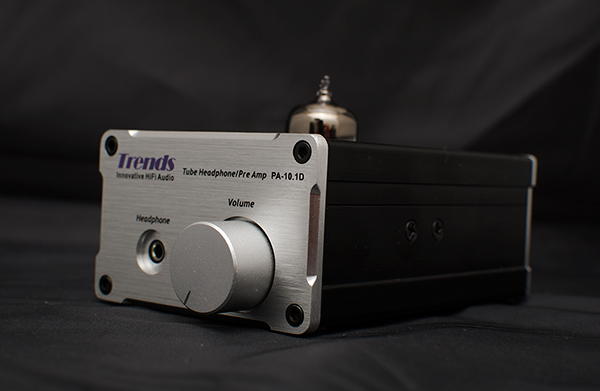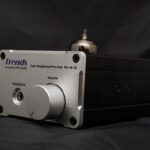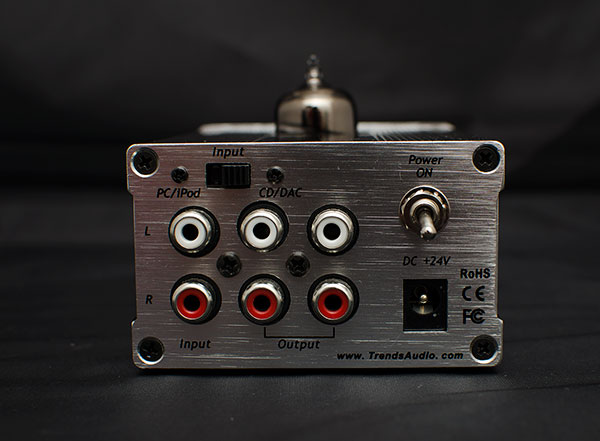The Trends Audio PA-10.1D is a compact hybrid desktop tube and resistor-based headphone/preamplifier. It is priced from $225
Disclaimer: The Trends Audio PA-10.1D sent to us is a loan sample in exchange for our honest opinion. We thank the team at Trends Audio for giving us this opportunity.
To read more about tube amps we have featured on Headfonics click here.
Note, this review follows our new scoring guidelines for 2021 which you can read up on here.
I have been seeing a lot of aggressive marketing from Trends Audio over the last year or two so it was only logical that we would bump into each other eventually.
Sure enough, David Ho of Trends Audio HK kindly allowed us to take a crack at one of their new product rollouts, the upgraded PA-10 – the PA-10.1D SE. This is a tiny little desktop tube amp in black and silver and sporting a couple of nifty little features, that put in the right hands, can actually turn out to be a mod and roller’s delight.
I covered some small tube constructs before in the Bravo series and whilst being very impressed by the quality to price ratio it does become apparent over a period of time that massive dollops of gain do not equate to a better listening experience.
True $100 gets you a lot but if you hanker for a bit more you are eventually going to want to upgrade. Coming in at $299 I guess you can call the PA-10.1D an upgrade of sorts though once you hit $200-300 you are in some very stiff competitive amping territory for whatever your needs are.
You have already bypassed the $150 Hifiman EF2A and starting to touch upon the Schiit Valhalla and the Little Dot MK3 which are already proven products in the market. The PA-10.1D by all accounts received some excellent feedback being described as possessing excellent clarity, punchy bass without being too forward, and plenty of presence.
Design
Opening up the PA-10.1D I was kind of surprised at how small it actually was. Yes, the Bravo Ocean was smaller but the pictures of the 10.1D tricked my mind into thinking it was somewhat larger.
The front sport a fairly clean design consisting of the volume pot, a 3.5mm input headphone jack stage, and the Trends Audio logo. The back is where the action really is with the gain switch, some bi-amp outputs (CD/DAC) and one set of inputs (PC/iPod), and the power and ac inputs.
The gain switch measures roughly in and around 3X on 250mW on low gain and maybe 5x on its high gain which is a fairly steep jump and you will hear that in almost headphone configs you choose to run with though varying degrees of performance and quality.
The PA-10.1D actually comes in around 80% size of the FiiO E09k and pretty much the same form factor. The PA-10.1D takes two series of tubes, the 12AU7 and the 6DJ8/6922 rather than stick to one particular family of tubes.
Tubes
An internal jumper switch setting gives this small amp a surprisingly large amount of tube choices for rolling enthusiasts. This one came with a stock Soviet 6H23N which is known for thicker bass response.
Most of the review will be based on that because sadly I am out of 12Au7’s for a while now though a few of the guys just yesterday managed to do some great mod work and without the joy of listening in person I am told it is simply a “beast”.
One thing that puzzled me was the use of a single 3.5mm jack at the front forcing me to grab my Grado quarter to 3.5mm adaptor for most of my test units.
I have read some that say oh well it’s small so 3.5mm makes sense but if that is so then how did the FiiO E9, being only marginally bigger, manage to fit a 3.5mm and a quarter input jack all in the same casing? I think a quarter would have been a wiser choice if possible.
Overall though the PA-10.1D felt pretty robust and durable, tiny enough to be transportable for desktop use and flexible enough for DIY and tube rollers to get a setup that might suit their tastes based on the specs and build.
Sound Impressions
The PA-10.1D acts as both a primary headphone amp and a pre-amp though we decided to stick to the headphone stage for this review to keep everything in context. Whilst the P-10.1D was fairly powerful for what it is but there were some limitations in the stock configuration and tube and true enough these limitations showed up in some of the cans we tested it with.
The house sound of the PA-10.1D with the stock tube could be best described as reasonably rich tonally with a warm to neutral signature and a more than forgiving top end. There is a prominent bass section and excellent transients. It does not possess the most expansive sound stage or the most detailed imaging, sometimes coming across as a little congested on more complex tracks.
Planar Pairings
For planers, the power was not there in the stock configuration. Both the HE6 and LCD-2 rev 2 maxed pretty quick with audio distortion coming before we hit 12 noon on the pot. The HE6 needs more juice and coming from the Mjolnir and the EF6 the drop was noticeable and reminded me of the early days hunting for something that did those cans justice.
The LCD-2 rev 2 managed around 12 noon on low gain and 10am on high gain. It performed better than the HE6 regarding volume levels especially on high gain setting but noticeable distortion like the HE6 coming in on high gain at around 11-12 noon and low gain just didn’t cut it with distortion coming in at acceptable volume levels.
I am not sure why people are talking great things about planer performance with the PA-10.1D because volume-wise it is possible to get just the right level but distortion quickly sets in and honestly there is not enough power even if there is a ton of gain it just won’t allow planers like the LCD-2 and HE6 to shine.
Pity I don’t have the HE400 around me anymore but it’s a better bet for this amp being the easiest planer of the Hifiman range to drive.
Dynamic Headphone Pairings
The Beyer DT770 32ohm LE much a much better experience with a very clean and noise-free background, especially on vocal tracks – no sharp attack or high sibilance on the stock tube.
It wasn’t overly warm or analog but a good level of clarity. It had no problems with churning out the weighty DT770 LE 32 ohm bass or being able to make the smooth treble sparkle sound surprisingly well-controlled, articulate, and musical.
The Philips Citiscape Downtown came in at a high gain 9 am and a low gain 12 noon. The Dowbntown’s slightly inefficient driver makes a good match for better control than the DT770 32ohm edition using the stock tube.
It had no problems in powering but there was a bit more grain and dry upper mids/lower treble but a good strong bass performance without it being overpowering – excellent sub-bass performance, perhaps best I heard from the Downtown yet without any pronounced mid-bass hump to get in the way.
Audio Technica & AKG
The ATH-ESW9 came in roughly at 9 am on high gain and 10 am on low gain. Running Benny Benassi- Everybody Everybody (vs Blackbox) it had a decent mix of vocals and dance beats – mids a bit further back with a more dominant bass reproduction and a smooth treble (which is the ESW9 for me in a nutshell anyhow).
The ESW9 was pretty easily driven giving a warm and liquid sonic quality without any sharpness. The tube experience was best represented for me with the warm ESW9 and the stock 6H23n.
The ATH-ESW10 played adequately just above 8 am on the high gain and 10 am on the low gain was displayed a more open and expressive midsection with slightly less coloration and not quite as warm as the ESW9 but still a very smooth reproduction.
The ESW11 LTD showed off the PA-10.1D’s excellent transients without any harshness. The bass is strong but not overly dominant. The dynamics of the ESW11 for me outperform that of the ESW9 – just a touch more sparkle and clarity.
The AKG K501 – for volume about 10 am on high gain and 12 noon on low gain. This was less of a good match, more of a deathmatch. Frankly, I was not surprised with its lack of depth and bass texture, losing a lot of top-end extension, producing a much-reduced soundstage to what I normally enjoy with the K501.
Yes, the K501 takes another victim. You really need natural power and not gain to make these babies tick.
IEMs
Final Audio’s FI-BA-SS was the first and only IEM that I tried with the PA-10.1D. I just could not see anyone going for an IEM setup like this but curiosity got the better of me and I wish it had not.
There was channel imbalance at low volumes starting out at around 7 am. There was a slightly better control on the low gain setting but this was not a good match with the FI-BA-SS sounding very tight and giving a very harsh lower treble reproduction, shallow bass, and thin mids.
Stock tubes are a miss for me with this setup but honestly, I don’t see anyone matching these two together – very different spectrums in terms of usage.
Modding afternotes
Some of the grassroots guys here took it apart after this review replacing the stock caps with black gate capacitors, silver foil resistors putting the output stage at 600ohms, and throwing in a good quality 12au7n tube and renaming the PA-10.1D “the little beast”.
I have yet to hear it but the owner placed it proudly beside his Woo WA6 so I kind of trust his opinion on this and as I said right at the start there does seem to be plenty of potential in the PA-10.1D SE beyond the stock mode if you know what you are doing.
Our Verdict
I enjoyed the Trends Audio PA-10.1D once I found the right match. The small form factor, flexible rolling capabilities, and high mod potential make it a really versatile tube amp with bags of potential in the right hands.
The bi-amping capability is a great feature for those who need it but we headphile nuts really want an array of headphone options and I do wish it had that quarter jack option to give it a more hardcore impression than it is for can jammers.
The tube options are pretty great though and most seem to opt for the 12au7n as the preferred tube option opening this little guy right up and giving it a chance to really shine.
In a stock format with the SE Soviet 6H23N tube, my feeling is that PA-10.1D is reasonably ok with a bass bias and excellent transients but at $299 I would opt for the GE edition which sports the 12au7n out of the box, and go from there.
Trends Audio PA-10.1D Technical Specs
- Including Limited Edition Russian 6H23n
- Dimensions: (W)76mm x (H)46 mm x (D)114 mm[case only]/150 mm[incl. sockets & knob]
- Weight: 300g
- Spec. (Power Unit):
- AC Input Voltage: Universal AC 100V-240V / 50~60Hz
- DC Output Voltage: DC 24V / 0.6A
- Dimensions: 65 mm(L) x 60 mm(W) x 105 mm(H)
- Weight: 150g




